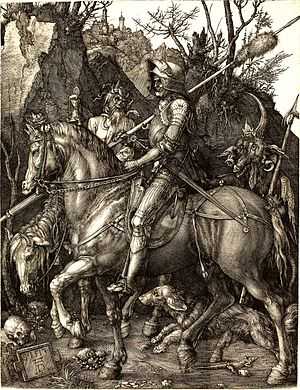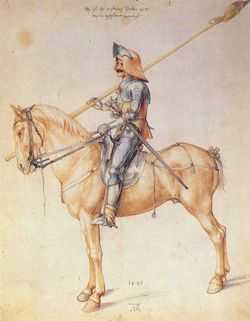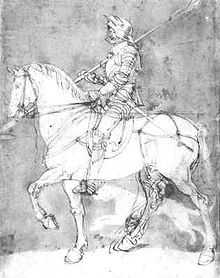Knight, Death and the Devil
| German: Ritter, Tod und Teufel | |
|---|---|
 | |
| Artist | Albrecht Dürer |
| Year | 1513 |
| Type | Copper engraving |
| Dimensions | 24.5 cm × 19.1 cm (9.6 in × 7.5 in) |
| Location | Multiple museum collections |
Knight, Death and the Devil (German: Ritter, Tod und Teufel) is a large 1513 engraving, one of the three "master prints" of the German artist Albrecht Dürer. The print portrays an armoured knight, accompanied by his faithful dog, riding through a narrow gorge flanked by a goat-headed devil and the figure of death riding a pale horse. Death holds an hourglass to remind the knight of the shortness of his life. The rider moves through the scene ignoring or looking away from the creatures lurking around him. He appears to be almost contemptuous of the threats, and as such is often seen to be a symbol of courage.[1]
Death, the Devil, and the landscape are all rendered in a bleakly northern manner. The surrounding characters are threatening to the knight, who is seemingly protected by the literal and figurative armor of his faith. It is believed by some art historians to be linked with publications of the Dutch humanist and theologian Erasmus's Enchiridion militis Christiani (Handbook of a Christian soldier).[2] The engraving draws from Psalm 23; "Though I walk through the valley of the shadow of death, I will fear no evil".[3] Knight, Death and the Devil is dated and signed by the artist; the bottom left of the tablet is scribed "S. (=Salus/in the year of grace) 1513."[4]
Most print rooms with a significant collection will have a copy, and there are many, often late and worn, impressions in private collections. The print was copied by other artists.
Composition
The engraving is heavily indebted to the Gothic style. Many of the forms blend into each other. The outline of the horse is built from a series of interlocking curves, while the knight's chin is woven into the line of his helmet. These two central figures are surrounded by a tangled mass of branches, harness and hair, which according to art historian Raymond Stites contrast with the relatively solid figure of the knight and his horse to set them as a "tangible idea in a world of changing forms".[5] The man is shown looking doggedly straight ahead, he does not allow his line of vision be interrupted or distracted by the demons beside him.[6]
Death is shown with his horse in the left background, and rendered without nose or lips in lighter shades than the other figures.[5] A skull seen in the lower foreground, directly in the Knight's path, whilst a dog is running between the two horses.
Background and interpretation

The work was created while Dürer was in the service of the Emperor Maximilian but was not a commission and does not contain an overtly political message. Instead it reaches back to a medieval sense of morality, and is replete with Gothic imagery.[5][7] The engraving bears similarities in mood and tone to one of Dürer's other great prints Melencolia I. The knight seems resigned, and his facial features are downcast. His gloomy posture is in contrast to the sturdy look of his horse. While his armor may protect him, for now, against the surrounding demons, the skull on a stump is held in front of the horse and the fall of the sand held by death in the face of the knight. According to writer Dorothy Getlein, "there is a sense of obsolescence about the knight accompanied by Death and the Devil."[8] New York Times journalist Holland Cotter notes that the composition followed soon after Dürer's beloved mother died a painful death.

Moritz Thausing suggested that Dürer created Knight, Death and the Devil as part of a four-work cycle, designed to illustrate the four temperaments. According to Thausing, Knight, Death and the Devil was intended to represent sanguinity, hence the "S" engraved in the work.[9] It is generally believed that the portrayal is a literal, though pointed, celebration of the knight's Christian faith, and also of the ideals of Humanism. An alternative interpretation was presented in 1970 by writer Sten Karling, when he suggested that the work did not seek to glorify the knight, but instead depict a "robber Baron". Karling points to the lack of Christian or religious symbolism in the work and to the fox's tail wrapped on top the knight's lance – in Greek legend[10] the fox's tail was a symbol of greed, cunning and treachery, as well as lust and whoring.[4] Actually, knights were commonly depicted in contemporary art with a fox tail tied to the tip of their lance. Moreover the fox tail was a common form of protective amulet.[11]
Because of its high quality, the work is considered one among three of Dürer's "Meisterstiche" (master prints); along with Saint Jerome in His Study (1514) and Melencolia I (1514).[3] In particular, the horse is skillfully rendered in geometric shapes that call to mind Leonardo and reflect the Renaissance interest in natural sciences and anatomy.[4]
In popular culture
Argentine writer and poet Jorge Luis Borges wrote two poems based on the engraving, titled "Ritter, Tod, und Teufel" (I) and "Ritter, Tod und Teufel" (II). In the first he praises the knight's courage, writing, "Being / brave, Teuton, you surely will be / worthy of the Devil and Death."[12] In the second he compares his own state to the knight, writing, "It's me and not the Knight that the old, white-faced man, head crowned with writhing snakes, exhorts."[13]
Also used in Ranger Up©s tshirt Death whispers
References
- ↑ Bailey, 15
- ↑ "Knight, Death, and the Devil, 1513–14". MoMA. Retrieved on June 12, 2010.
- ↑ 3.0 3.1 "Albrecht Dürer, Knight, Death and the Devil, a copperplate engraving". British Museum. Retrieved on June 12, 2010.
- ↑ 4.0 4.1 4.2 Nürnberg, 74
- ↑ 5.0 5.1 5.2 Stites, 465
- ↑ Shaw, Daniel. "Epilogue". Journal of Psychoanalytic Inquiry, Volume 27, 2007
- ↑ Getlein & Getlein, 68
- ↑ Getlein & Getlein, 72
- ↑ Masters in art: a series of illustrated monographs, Volume 5. Bates and Guild Co., 1904. Pages 122–123.
- ↑ According to Physiologus text; see Nürnberg, 74
- ↑ The Landsknechts, Douglas Miller, pp. 10-11
- ↑ Borges , Jorges Luis. Trans. Norman Thomas di Giovanni. In Praise of Darkness. E.P. Dutton & Co, Inc., 1974, p. 98.
- ↑ Borges , Jorges Luis. Trans. Norman Thomas di Giovanni. In Praise of Darkness. E.P. Dutton & Co, Inc., 1974, p. 100.
Sources
- Bailey, Martin. Dürer. London: Phidon Press, 1995. ISBN 0-7148-3334-7
- Brion, Marcel. Dürer. London: Thames and Hudson, 1960.
- Getlein, Dorothy & Getlein, Dorothy V. The Bite of the Print: Satire and Irony in Woodcuts, Engravings, Etchings, Lithographs and Serigraphs. New York: C. N. Potter, 1963
- Nürnberg, Verlag Hans Carl. Dürer in Dublin: Engravings and woodcuts of Albrecht Dürer. Chester Beatty Library, 1983
- Panofsky, Erwin. The life and art of Albrecht Durer. Princeton University Press, 1945
- Sander, Jochen (ed). Dürer: His Art in Context. Frankfurt: Städel Museum & Prestel, 2013. ISBN 3-7913-5317-9
- Stites, Raymond. The Arts and Man. New York; London: Whittlesey House, McGraw-hill Book Company, Inc., 1940
External links
-
 Media related to Knight, Death and the Devil at Wikimedia Commons
Media related to Knight, Death and the Devil at Wikimedia Commons - Metropolitan Museum of Art entry
- British Museum entry
